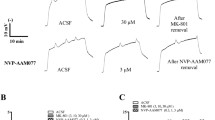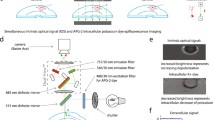Abstract
Spreading depression (SD) is a propagating wave of neuronal activity in the central nervous system and may play a role in triggering classical migraine. The retina serves as a model system for examining the phenomenon of SD and the influence of various drugs on it. After a SD wave passes a new wave can not be elicited in the absolute refractory period of the tissue (about 2min), this is followed by a relative refractory phase of about 20min before complete recovery. The aim of the present study was to describe the effects of Ba2+, a blocker of glial cell K+ channels, octanol, a gap junction blocker and diethylbarbiturate, a GABAA chloride channel-activating drug on the modulation of the refractory period of the retinal SD and to examine the possible mechanisms underlying this modulation. Two properties of SD, which are highly sensitive to any changes in the experimental conditions, are the propagation velocity of the wave and the accompanying slow negative potential shift. We measured the propagation velocity and the field potential amplitude in the chicken retina as a function of the recovery state of the tissue under control conditions and compared them with measurements in the presence of Ba2+, octanol or diethylbarbiturate. Under these conditions the manner of the recovery of the tissue changed significantly. Although after blocking the glial (Müller) cell K+ channels with Ba2+ (200μM), the curve of recovery of the propagation velocity to its maximum value has the same shape as under control conditions, the propagation velocity is reduced in the whole recovery period and in the recovered retina to 84% of the control velocity. The importance of electrical coupling in the refractory phase and in the recovered tissue was examined by adding octanol (1mM) to the perfusion solution. In this case the relative recovery phase was shortened and the field potential amplitude (110% of control) and propagation velocity (112% of control) are increased in the completely recovered retina. With the GABAA-chloride channel-activating drug diethylbarbiturate (800μM) the propagation velocity (112% of control) and the amplitude of the field potential (111% of control) in the complete recovered retina are increased, but this seems to have no influence on the refractory state.
Similar content being viewed by others
Author information
Authors and Affiliations
Additional information
Received: 2 September 1997 / Accepted: 20 November 1997
Rights and permissions
About this article
Cite this article
Brand, S., Fernandes de Lima, V. & Hanke, W. Pharmacological modulation of the refractory period of retinal spreading depression. Naunyn-Schmiedeberg's Arch Pharmacol 357, 419–425 (1998). https://doi.org/10.1007/PL00005188
Issue Date:
DOI: https://doi.org/10.1007/PL00005188




